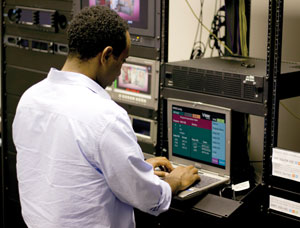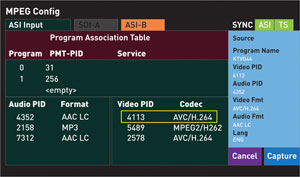MPEG TS monitoring
Perhaps no other trend is doing more to shape today’s media landscape than multiplatform content delivery, driven by the explosion in mobile devices and consumers’ growing and insatiable appetite for content they can access “anytime and anywhere.” Broadcasting operations that were designed for traditional, linear transmissions are becoming much more complex, with many more elements being added to the transmission chain and the requirement to deliver every possible transport stream — satellite, cable, free to air, Web streaming, and delivery to different platforms including 4G mobile devices. Troubleshooting transmission problems has never been more critical or more time-consuming.

Teddy Demilew, Wohler engineer, performs MPEG TS monitoring using one of several lower-cost video monitors placed throughout a media facility. This new trend offers much greater flexibility.
As broadcasters and content providers grapple with adapting their operations to multiplatform delivery, they have placed a premium on finding alternate test-and-measurement systems that can offer a simplified interface while providing an adequate level of signal analysis. Placed throughout the media facility, lower-cost video monitors that incorporate MPEG-2 and MPEG-4 TS monitoring offer much greater flexibility in monitoring and analyzing video, audio and metadata at any point in the signal flow, whether inside or outside the central HD-SDI infrastructure.
This article will discuss the latest advances in chipset and technology development that are enabling compact, affordable MPEG monitoring solutions. By providing integrated support for DVB-ASI, MPEG-2 and MPEG-4 transport streams, these new monitors are playing a critical role in helping broadcasters and other content providers improve the efficiency and agility of their monitoring operations — and, ultimately, the integrity of the final signal they deliver to viewers.
Multiplatform MPEG monitoring
MPEG monitoring equipment is not a new fixture in media facilities; in fact, it has always been a requirement in any operation that relies on some type of MPEG transport stream for content delivery: free-to-air stations, pay-TV networks, video over IP and mobile-TV providers. Traditional MPEG monitoring systems are high-end and expensive and are designed for detailed, byte-by-byte analysis; fault logging; and display of each MPEG stream.
In an operation with multiple transport streams, with different transcoding formats and resolutions required for different device types, it is not feasible or cost-effective to install a high-end monitoring system for multipoint probing of every stream. The ideal solution, therefore, is a low-cost monitoring platform that can perform a sort of triage on the stream at key points in the transmission path by interrogating it at a basic level, and then handing the signal off to higher-end equipment if a fault condition is detected.
The professional video industry's #1 source for news, trends and product and tech information. Sign up below.
At the most basic level, monitoring provides selection and decoding of the video image and associated audio to allow confirmation of the content, especially if it is being delivered in multiple languages, such as is the case in global sports. The next level of monitoring should provide basic analysis of MPEG errors capable of preventing user devices from properly decoding content. These include packet header errors, such as sync byte or continuity count (which indicates dropped packets), or program mapping errors such as program allocation table (PAT), program map table (PMT), or missing stream PIDs, such as the one shown in Figure 1.

Figure 1. Multiplatform operations often use lower-cost monitoring systems to check for faults at key points in the transmission path. One such point is analysis of MPEG errors — including missing stream PIDs — capable of preventing user devices from properly decoding content.
Advanced monitoring capabilities include detection of black screen, lost or frozen video, or loss of audio from the decoded MPEG streams. In each of these cases, errors should be reportable both locally by the monitoring device and remotely to an operator and/or QC process equipped to further diagnose and correct the errors. Once an error has been reported, a high-end, advanced monitoring device can provide a logged, detailed analysis of the source of the fault.
Lower-cost multistream monitoring
New, lower-cost devices for monitoring MPEG transport streams owe their existence to the explosion of chipsets for smartphones, tablet computers and other mobile devices. Working in tandem with field-programmable gate arrays (FPGAs), as shown in Figure 2, these chipsets provide a powerful one-two punch for the resource-intensive tasks of decoding MPEG-2 and MPEG-4 input sources and identifying anomalies in the TS wrapper. Typically, these chipsets can accommodate the many flavors of MPEG, including MPEG-2, MPEG-4 H.264, and JPEG2000.

Figure 2. Newly developed chipsets working in tandem with FPGAs decode input sources in a variety of MPEG flavors and identify anomalies in the TS wrapper.
In monitoring systems that work at the “triage” level, the FPGA pre-processes the packet by breaking out the rudimentary stream and performing cursory analysis of the wrapper to identify potential transmission errors. At this base level, the monitor can flag subset errors that might impair decoding and cause artifacts in the decoded picture, or those that will prevent the content from being decoded altogether. The FPGA passes the unwrapped elementary components of the MPEG video and audio content for decoding by a hardware-based MPEG decoder — typically comprised of an ARM or DSP processing core and a custom 3-D video/graphic hardware engine — which outputs the MPEG content to baseband video and audio for either local or remote monitoring.
Other important considerations
In evaluating available multistream MPEG monitors, media operations should factor in other important attributes. First, for an operation with many distribution points at remote, unmanned sites, the system should enable remote monitoring and alarming via the Internet. The monitoring devices (if physical product) or user interface (if software-based), should be simple and intuitive.
In the event of error detection, the monitor should provide automatic notification to an external device, or posting of an error message on the monitoring device itself, transmission of an automatic email notification or text message to a mobile phone, or SNMP trap. The monitor should also provide a clear onscreen display of the stream experiencing the error. Many current monitoring platforms provide for capture and forward of an offending clip or datastream so that further analysis and error correction can be performed.
—Brian Petersson serves as video design engineering manager at Wohler Technologies.
